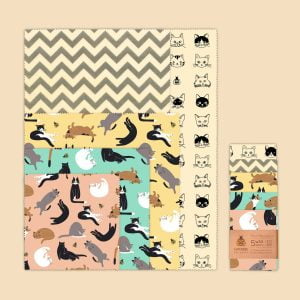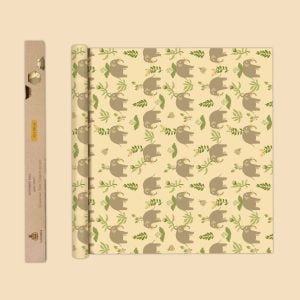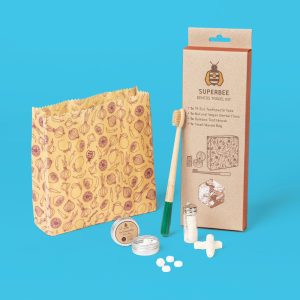What Is Zero Waste Packaging?

What is zero waste packaging and how big of an impact does it actually make?
Zero waste packaging has emerged as a crucial part of sustainable living, particularly while shopping for zero waste kitchen products. As concerns about environmental conservation and waste reduction continue to grow, consumers and businesses alike are seeking alternatives to traditional packaging methods that contribute to pollution and landfill waste.
This packaging represents a paradigm shift towards packaging solutions that prioritize reuse, recyclability, and compostability. The aim is to minimize the environmental impact of packaging materials throughout their lifecycle, which is ideal when considering the wasteful packaging options found in nearly every industry
In this post, we’ll explore the concept of zero waste packaging in depth. We’ll go over its applications in various industries, its distinctions from biodegradable packaging, and provide examples and ideas to inspire sustainable packaging practices.
Keep reading to learn more about the principles behind zero waste packaging and discover how you can play a role in promoting a more sustainable future through your packaging choices.
What Is Zero Waste Packaging for Food?
Zero waste packaging for food encompasses packaging solutions that minimize or eliminate waste throughout the entire lifecycle of food products. Unlike traditional packaging, which often ends up in landfills after a single use, zero waste food packaging aims to reduce environmental impact by prioritizing reusable, recyclable, and compostable materials.
This approach to packaging involves strategies such as using reusable containers, jars, or bags for bulk food items, opting for compostable or biodegradable packaging materials made from renewable resources like plant-based plastics or recycled paper, and encouraging consumers to bring their own containers or bags when shopping for groceries.
Zero waste food packaging often emphasizes minimalism and simplicity. This is why you’ll notice that many zero waste packaging for food options avoid unnecessary layers of packaging or single-use plastics that contribute to pollution and waste.
By adopting zero waste packaging practices for food, individuals, businesses, and communities can contribute to plastic pollution reductions, natural resource conservation, and sustainable food system promotion.
Is Zero Waste Packaging the Same as Biodegradable Packaging?
While zero waste packaging and biodegradable packaging share the same goal of reducing environmental impact, they’re not the same. Zero waste packaging focuses on minimizing waste throughout the entire lifecycle of the packaging material, from production to disposal. This includes strategies such as reusability, recyclability, and compostability to ensure that packaging materials have minimal impact on the environment.
On the other hand, biodegradable packaging refers to materials that can break down naturally over time through biological processes, such as decomposition by microorganisms. While biodegradable packaging may seem environmentally friendly at first glance, it’s important to note that not all biodegradable materials are created equal. Some biodegradable plastics, for example, may require specific conditions to degrade properly. Also, they may still leave behind harmful residues or microplastics.
In contrast, zero waste packaging focuses on reducing overall waste generation by prioritizing reusable, recyclable, and compostable materials, thereby minimizing the need for disposal in landfills or incineration. Even though biodegradable packaging can be a component of zero waste packaging solutions, it’s just one aspect of a broader approach to sustainability in packaging practices.
Zero Waste Packaging Examples
Zero waste packaging encompasses a wide range of materials and design strategies aimed at minimizing environmental impact. Here we list out and explain some examples of zero waste packaging worth considering.
Reusable Containers
Reusable containers, such as glass jars, stainless steel tins, and silicone bags, are excellent alternatives to single-use packaging. These containers offer durability and versatility, allowing them to be used repeatedly for storing various items.
Glass jars, for example, are perfect for storing dry goods like grains, nuts, and spices, while stainless steel tins are ideal for holding snacks, lunches, and leftovers. Silicone bags are a flexible option for storing both food and non-food items, offering airtight seals to keep contents fresh.
By investing in reusable containers, it’s possible to significantly reduce reliance on disposable packaging and minimize waste generation. But besides reducing waste, reusable containers also offer economic benefits.
Even though the initial cost of purchasing reusable containers may be higher than disposable alternatives, their durability ensures long-term savings. Instead of continuously purchasing single-use packaging, you’ll reuse your containers countless times, saving money in the long run. Ultimately, by choosing high-quality reusable containers, you can avoid the need for frequent replacements, which further reduces your environmental footprint.
Compostable Packaging
Compostable packaging is another sustainable option for minimizing waste. Made from organic materials that break down into nutrient-rich compost, compostable packaging offers an eco-friendly alternative to traditional plastics.
Materials such as compostable PLA (polylactic acid), paper, cardboard, and certain types of bioplastics can be composted along with organic waste. This diverts them from landfills and reduces greenhouse gas emissions.
Compostable packaging is particularly beneficial for food and organic waste. This is because it can be composted in municipal or home composting systems, returning valuable nutrients to the soil.
When considering compostable packaging, it’s essential to choose products certified as compostable by reputable organizations. Certification ensures that the packaging meets specific standards for biodegradability and compostability, ensuring proper decomposition in composting environments. By choosing compostable packaging and composting it correctly, you’re contributing to soil health, reducing waste sent to landfills, and supporting a circular economy.
Recyclable Materials
Recyclable materials play a crucial role in zero waste packaging solutions. These materials can be collected, processed, and remanufactured into new products, reducing the need for virgin materials and minimizing waste generation.
Common recyclable materials include paper, cardboard, aluminum, and certain types of plastics. By choosing packaging made from recyclable materials, you’ll help close the recycling loop and promote a circular economy. But it’s equally important to remember that recycling packaging materials conserves natural resources, reduces energy consumption, and decreases greenhouse gas emissions associated with production processes.
When selecting recyclable packaging, it’s essential to consider the recycling infrastructure available in your area. Not all materials are accepted for recycling in every community, so it’s crucial to check local recycling guidelines and ensure that packaging materials can be recycled locally.
Proper sorting and preparation of recyclable materials are necessary to facilitate the recycling process effectively. By understanding and following recycling guidelines, it’s possible to maximize the recycling potential of packaging materials and contribute to a more sustainable waste management system.
Innovative Alternatives
Innovative alternatives to traditional packaging materials are emerging as viable solutions for zero waste packaging. These alternatives often utilize renewable, biodegradable, or compostable materials derived from plants, fungi, or algae.
Examples include packaging made from mushroom mycelium, seaweed-based films, and biodegradable plastics derived from agricultural waste. These innovative materials offer sustainable alternatives to conventional plastics and can help reduce the environmental impact of packaging waste. They also usually biodegrade more rapidly than traditional plastics, reducing the longevity of plastic pollution in the environment.
As technology and research continue to advance, the development of new and improved packaging materials is expected to accelerate. Companies and consumers alike are increasingly embracing innovative alternatives to traditional packaging, driving demand for sustainable packaging solutions.
Building a Greener Future with Responsible Packaging
Embracing sustainable packaging is essential for building a greener future and reducing our environmental footprint. By choosing zero waste packaging options and advocating for eco-friendly practices, we can make a significant impact on preserving our planet for future generations.
It’s time to empower consumers through responsible choices and join forces for environmental conservation. Together, we can advance towards zero waste and create a more sustainable world for all. Bee the change you want to see with SuperBee!




